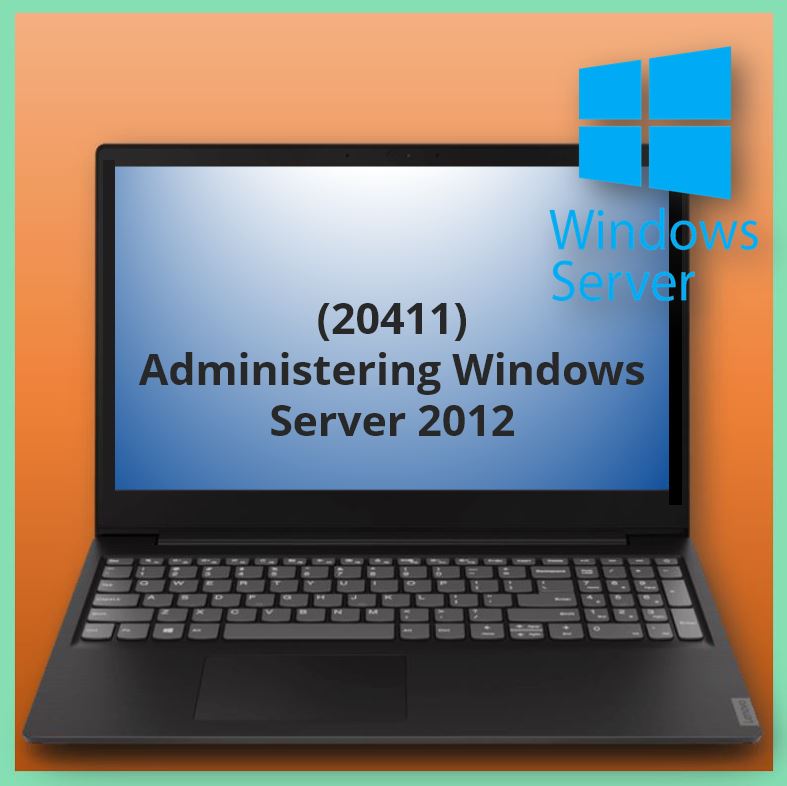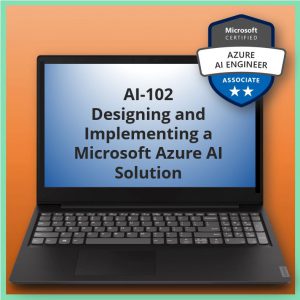Aangeboden leervormen
Administering Windows Server 2012 (20411)
Course Description
This course is part two in a series of three courses that provides the skills and knowledge necessary to implement a core Windows Server 2012 infrastructure in an existing enterprise environment.
The three courses collectively cover implementing, managing, maintaining and provisioning services and infrastructure in a Windows Server 2012 environment. Although there is some cross-over of skills and tasks across these courses, this course focuses on the administration tasks necessary to maintain a Windows Server 2012 infrastructure such as configuring and troubleshooting name resolution, user and group management with Active Directory Domain Services (AD DS) and Group Policy, implementing Remote Access solutions such as DirectAccess, VPNs and Web Application Proxy, implementing Network Policies and Network Access Protection, Data Security, deployment and maintenance of server images, as well as update management and monitoring of Windows Server 2012 environments.
This course maps directly to and is the preferred choice for hands-on preparation for Microsoft Certified Solutions Associate (MCSA): Exam 411: Administering Windows Server 2012, which is the second of three exams required for MCSA: Windows Server 2012 credential.
At Course Completion
After completing this course, students will be able to:
· Implementing a Group Policy Infrastructure
· Managing User Desktops with Group Policy
· Managing User and Service Accounts
· Maintaining Active Directory Domain Services
· Configuring and Troubleshooting DNS
· Configuring and Troubleshooting Remote Access
· Installing, Configuring, and Troubleshooting the Network Policy Server role
· Implementing Network Access Protection
· Optimizing File Services
· Configuring Encryption and Advanced Auditing
· Monitoring Windows Server 2012
· Deploying and Maintaining Server Images
· Implementing Update Management
Voor wie
This course is intended for Information Technology (IT) Professionals with hands on experience working in a Windows server 2008 or Windows Server 2012 environment who wish to acquire the skills and knowledge necessary to be able to manage and maintain the core infrastructure required for a Windows Server 2012 and Windows Server 2012 R2 environment. The key focus for students is to broaden the initial deployment of Windows Server 2012 services and infrastructure and provide the skills necessary to Manage and Maintain a domain based Windows Server 2012 environment, providing skills in areas such as User and Group management, Network Access and Data Security. Candidates typically interested in attending this course would be
• Windows Server Administrators experienced in working with Windows Server 2008 or Windows Server 2012 who wish to gain skills necessary to perform daily management and maintenance tasks in a Windows Server 2012 or Windows Server 2012 R2 environment.
• IT Professionals who are looking to take the 411, Administering Windows Server 2012 exam
• IT professional wishing to take the Microsoft Certified Solutions Expert (MCSE) exams in DataCenter, Desktop Infrastructure, Messaging, Collaboration and Communications will also be interested in taking this course as they prepare for the Microsoft Certified Solutions Associate (MCSA) exams, which are a pre-requisite for their individual specialties.
Programma
Module 1: Configuring and Troubleshooting Domain Name System
This module explains how to configure and troubleshoot DNS, including DNS replication and caching.
Lessons
· Configuring the DNS Server Role
· Configuring DNS Zones
· Configuring DNS Zone Transfers
· Managing and Troubleshooting DNS
Lab : Configuring and Troubleshooting DNS
· Configuring DNS Resource Records
· Configuring DNS Conditional Forwarding
· Installing and Configuring DNS Zones
· Troubleshooting DNS
After completing this module, students will be able to:
· Install and configure the DNS server role.
· Create and configure DNS zones.
· Configure DNS zone transfers.
· Manage and troubleshoot DNS.
Module 2: Maintaining Active Directory Domain Services
This module explains how to implement virtualized domain controllers and read-only domain controller (RODCs). It also explains how to perform common AD DS administrative tasks
and manage the AD DS Database.
Lessons
· Overview of AD DS
· Implementing Virtualized Domain Controllers
· Implementing RODCs
· Administering AD DS
· Managing the AD DS Database
Lab : Maintaining AD DS
· Installing and Configuring a RODC
· Configuring AD DS Snapshots
· Configuring the Active Directory Recycle Bin
· Cloning a domain controller
After completing this module, students will be able to:
· Explain the general structure of AD DS.
· Implement virtualized domain controllers.
· Implement RODCs.
· Administer AD DS.
· Manage the AD DS database
Module 3: Managing User and Service Accounts
This module explains how to create, configure and automate the creation of user accounts. It also explains how to configure account-related properties of user objects. It further explains how to create and administer Managed Service Accounts.
Lessons
· Configuring Password Policy and User Account Lockout Settings
· Configuring Managed Service Accounts
Lab : Managing User and Service Accounts
· Configuring Password Policy and Account Lockout Settings
· Creating and Associating a Managed Service Account
After completing this module, students will be able to:
· Configure password policy and user account lockout settings.
· Configure managed service accounts.
Module 4: Implementing a Group Policy Infrastructure
This module explains how to implement a GPO infrastructure. This also teaches how to perform common GPO management tasks, and manage GPOs by using Windows PowerShell. It also focuses on troubleshooting the application of GPOs.
Lessons
· Introducing Group Policy
· Implementing and Administering GPOs
· Group Policy Scope and Group Policy Processing
· Troubleshooting the Application of GPOs
Lab : Implementing a Group Policy Infrastructure
· Creating and Configuring Group Policy Objects
· Managing GPO Scope
· Verify GPO Application
· Managing GPOs
After completing this module, students will be able to:
· Describe the components and technologies that comprise the Group Policy framework.
· Configure and understand a variety of policy setting types.
· Scope GPOs by using links, security groups, Microsoft Windows Management Instrumentation (WMI) filters, loopback processing, and preference targeting.
· Describe how GPOs are processed.
· Locate the event logs that contain Group Policy-related events and troubleshoot the Group Policy application
Module 5: Managing User Desktops with Group Policy
This module explains how you can use Group Policy Objects (GPOs) to implement desktop environments across your organization by using Administrative Templates, Folder Redirection, Group Policy preferences, and where applicable, use software deployment to install and update application programs. It is important to know how to use these various GPO features so that you can configure your users’ computer settings properly.
Lessons
· Implementing Administrative Templates
· Configuring Folder Redirection and Scripts
· Configuring Group Policy Preferences
· Managing Software with Group Policy
Lab : Managing User Desktops with Group Policy
· Implement Settings by Using Group Policy Preferences
· Managing Office 2013 by using Administrative Templates
· Deploying Software by using Group Policy
· Configuring Folder Redirection
After completing this module, students will be able to:
· Describe and implement Administrative Templates
· Configure folder redirection and scripts by using GPOs
· Configure GPO preferences
· Deploy software by using GPOs
Module 6: Implementing Remote Access
In this module, you will learn how to implement and manage remote access in Windows Server 2012. You will also learn how to implement DirectAccess by using the Getting Started wizard, implement and manage an advanced DirectAccess infrastructure, and implement VPN.
Lessons
· Overview of Remote Access
· Implementing DirectAccess by Using the Getting Started Wizard
· Implementing and Managing an Advanced DirectAccess Infrastructure
· Implementing VPN
· Implementing Web Application Proxy
Lab : Implementing DirectAccess by Using the Getting Started Wizard
· Verifying Readiness for a DirectAccess Deployment
· Configuring DirectAccess
· Validating the DirectAccess Deployment
Lab : Deploying an Advanced DirectAccess Solution
· Preparing the Environment for DirectAccess
· Implementing the Advanced DirectAccess Infrastructure
· Validating the DirectAccess Deployment
Lab : Implementing VPN
· Implementing VPN
· Validating the VPN Deployment
Lab : Implementing Web Application Proxy
· Implementing Web Application Proxy
· Validating the Web Application Proxy Deployment
After completing this module, students will be able to:
· Install and manage the Remote Access role in Windows Server 2012
· Implement DirectAccess by using the Getting Started Wizard
· Implement and manage an advanced DirectAccess Infrastructure
· Implement VPN access
· Implement Web Application Proxy
Module 7: Installing, Configuring, and Troubleshooting the Network Policy Server Role
This module explains how to install and configure NPS, RADIUS Clients and servers. It also describes NPS authentication methods. It describe NPS authentication methods and how to
monitor and troubleshoot NPS.
Lessons
· Installing and Configuring a Network Policy Server
· Configuring RADIUS Clients and Servers
· NPS Authentication Methods
· Monitoring and Troubleshooting a Network Policy Server
Lab : Installing and Configuring a Network Policy Server
· Installing and Configuring NPS to Support RADIUS
· Configuring and Testing a RADIUS Client
After completing this module, students will be able to:
· Install and configure NPS
· Configure both RADIUS clients and servers
· Describe NPS authentication methods
· Monitor and troubleshoot NPS
Module 8: Implementing Network Access Protection
This module explains how to configure, monitor, and troubleshoot NAP. It also explains how NAP can help to protect your network and the various NAP enforcement processes.
Lessons
· Overview of Network Access Protection
· Overview of NAP Enforcement Processes
· Configuring NAP
· Configuring IPSec Enforcement for NAP
· Monitoring and Troubleshooting NAP
Lab : Implementing Network Access Protection
· Configuring NAP Components
· Configuring Virtual Private Network Access
· Configuring the Client Settings to Support NAP
After completing this module, students will be able to:
· Describe how NAP can help to protect your network
· Describe the various NAP enforcement processes
· Configure NAP
· Monitor and troubleshoot NAP
Module 9: Optimizing File Services
This module describes FSRM, configure quotas, file screening, and storage reports and implement classification management and file management tasks. It describes the components of the DFS. I also explains how to configure DFS namespaces and DFS replication.
Lessons
· Overview of FSRM
· Using FSRM to Manage Quotas, File Screens, and Storage Reports
· Implementing Classification and File Management Tasks
· Overview of DFS
· Configuring DFS Namespaces
· Configuring and Troubleshooting DFS Replication
Lab : Configuring Quotas and File Screening Using File Server Resource Manager
· Configuring File Server Resource Manager Quotas
· Configuring File Screening and Storage Reports
Lab : Implementing Distributed File System
· Installing the DFS role service
· Configuring a DFS Namespace
· Configuring DFS Replication
After completing this module, students will be able to:
· Describe FSRM.
· Use FSRM to manage quotas, file screens, and storage reports.
· Implement classification and file management tasks.
· Describe DFS.
· Configure DFS namespaces.
· Configure and troubleshoot DFS Replication
Module 10: Configuring Encryption and Advanced Auditing
This module explains how to encrypt files using EFS and configure advanced auditing features.
Lessons
· Encrypting Drives by Using BitLocker
· Encrypting Files by Using EFS
· Configuring Advanced Auditing
Lab : Configuring Encryption and Advanced Auditing
· Encrypting and Recovering Files
· Configuring Advanced Auditing
· Using Windows BitLocker Drive Encryption to Secure Data Drives
After completing this module, students will be able to:
· Encrypt hard drives by using Windows BitLocker Drive Encryption.
· Encrypt files by using Encrypting File System (EFS).
· Configure advanced auditing
Module 11: Deploying and Maintaining Server Images
This module explains how to create and manage server images by using Windows Deployment Services
Lessons
· Overview of Windows Deployment Services
· Managing Images
· Implementing Deployment with Windows Deployment Services
· Administering Windows Deployment Services
Lab : Using Windows Deployment Services to Deploy Windows Server 2012
· Installing and Configuring Windows Deployment Services
· Creating Operating System Images with Windows Deployment Services
· Configuring Custom Computer Naming
· Deploying Images with Windows Deployment Services
After completing this module, students will be able to:
· Describe the important features and functionality of Windows Deployment Services.
· Manage images by using Windows Assessment and Deployment Kit (Windows ADK) Tools.
· Configure Windows Deployment Services in Windows Server 2012.
· Perform deployments with Windows Deployment Services.
Module 12: Implementing Update Management
This module explains how to use Windows Server Update Services (WSUS) to deploy updates to Windows servers and clients.
Lessons
· Overview of WSUS
· Deploying Updates with WSUS
Lab : Implementing Update Management
· Implementing the WSUS Server Role
· Configuring Update Settings
· Approving and Deploying an Update by using WSUS
After completing this module, students will be able to:
· Describe the role of WSUS.
· Describe the WSUS update management process.
· Deploy updates with WSUS.
Module 13: Monitoring Windows Server 2012
This module explains the monitoring tools available in Windows Server 2012. it also explains how to use Performance Monitor and monitor events.
Lessons
· Monitoring Tools
· Using Performance Monitor
· Monitoring Event Logs
Lab : Monitoring Windows Server 2012
· Establishing a Performance Baseline
· Identifying the Source of a Performance Problem
· Viewing and Configuring Centralized Event Logs
After completing this module, students will be able to:
· Describe the monitoring tools for the Windows Server 2012 operating system.
· Use Performance Monitor to view and analyze performance statistics of programs that are running on their servers.
· Monitor event logs to view and interpret the recorded events.
Voorkennis
Before attending this course, students must have:
• At least one years experience working with Windows Server 2008, Windows Server 2008 R2 or Windows Server 2012.
• Good knowledge and understanding of Active Directory and Networking Infrastructure
• Knowledge equivalent to the learning's covered in the “20410:Installing and Configuring Windows Server 2012” course, as this course will build upon that knowledge
Examen
Microsoft examen 70-411 Administering Windows Server 2012
Duur training
Open Leercentrum: 5 dagen
E=Learning: 90 dagen










